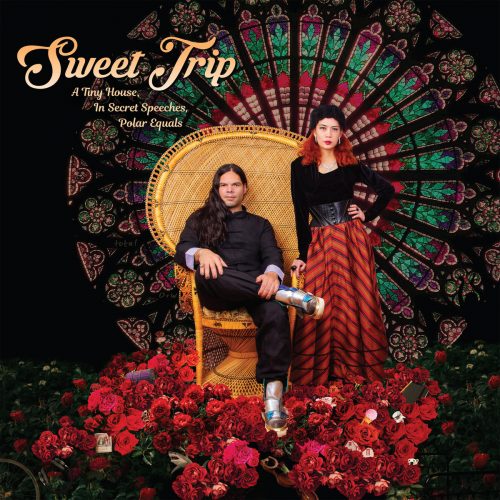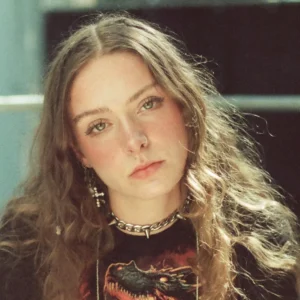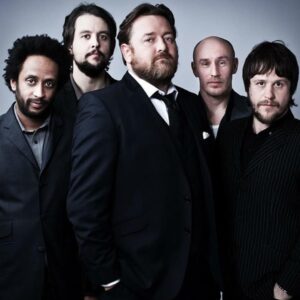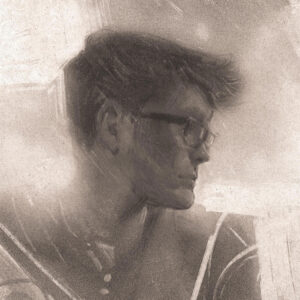My parents, bless them, didn’t know why I was so excited. I told them that I would be interviewing someone from a band called Sweet Trip, a band whose music I’ve loved and admired for some time, and they were happy for me. But they didn’t quite get why I was grinning from ear to ear like I had gotten a shiny new bicycle on Christmas morning.
My friends online, on the other hand, knew exactly why I was so excited. When I told them I was interviewing Roby Burgos from Sweet Trip, we hit the caps lock key and communicated through gibberish keysmashes like “SGHFHFGHSDGHGGHKGH,” occasionally punctuated with a joyous “I KNOW!” or a long, exultant “AAAAAAAAAA!” I consider myself a professional at this point, but no one should be so jaded that they can’t allow themselves the occasional giddy fanboying session. I was thrilled.
Those two different reactions illustrate what makes a band like Sweet Trip so special. Founded in the early 90s by San Francisco musicians Roberto Burgos, Valerie Cooper and Viet Le, Sweet Trip has released only four albums in almost thirty years of existence, but each one is beloved by their passionate online cult following. “We get a lot of DMs telling us this music saved them,” said Cooper in an interview with Sonemic, and it’s easy to hear why people have such intimate emotional connections with this music. From the futuristic utopian sounds of Halica and Velocity : Design : Comfort to the more straightforward dream pop sound of You Will Never Know Why, there’s a tenderness to Sweet Trip’s music, a sense that someone is sharing a secret with you. Sometimes it’s joyfully noisy, other times it’s stark and melancholy, but it’s always tremendously comforting. (I made my personal list of the best Sweet Trip songs, which you can find here.)
When Sweet Trip returned this year with their new album, A Tiny House, In Secret Speeches, Polar Equals, it felt like reuniting with an old friend. It’s been twelve years since You Will Never Know Why, and after the tumult and catastrophe of the past decade 2009 feels like a half-remembered dream. But A Tiny House makes it feel like it’s been no time at all: it’s an album that could have come out in 2012, and in this case that’s very much a good thing. After the release of “Things to Ponder While Falling,” a single that felt like a swan song, I thought I might never hear new music from Sweet Trip again. Listening to A Tiny House and hearing those familiar lush, evocative chord sequences, with Cooper’s silvery coo singing through the air…well, I’m not too proud to say that I came close to tears.
This is not to say, of course, that Sweet Trip has stagnated. Instead, A Tiny House feels like a culmination, containing elements of the three previous albums while carving out an identity of its own. You’ll find buzzing electronics (“A Tiny House”), swooning dream pop (“Snow Purple Treasures”), and sprawling, shapeshifting song structures (“Polar Equals”). More than anything, though, you’ll find warmth, tenderness, and optimism, in the most colorful and eclectic album of Sweet Trip’s existence. It’s impossible to pick a favorite album of theirs, but it might be this one.
I interviewed Roberto “Roby” Burgos about Sweet Trip’s beginnings, its journey through the years, and how it ended up here.
When you first formed Sweet Trip, what were your ambitions? Was there an end goal you had in mind, or did you just want to make music and see what happened?
When we started we had no ambitions whatsoever other than to make and play music, and like you said, to see what would happen. In fact Viet, who was an original member, had to push us to be more ambitious about the music we were making, and to embrace the potential we had. If it wasn’t for him, I personally would have been just happy as a bedroom musician, because at the time, I wasn’t thinking big at all. To me there were two goals that I cared to achieve: to make the music that I wanted to make; and secondly to make music that both Viet and Valerie, especially Valerie, would like. Valerie has always been a huge inspiration for me, and her approval always meant the world to me. She is the only person I care about the most to impress. Beyond that, to me, it was all a matter of chance and circumstance – if it is well received then, great! Otherwise, carry on.
Sweet Trip came about in the Bay Area music scene, which doesn’t necessarily get the same degree of attention as New York or Los Angeles. Is there anything unique about the Bay Area that shaped the band as we know it today?
I cannot compare the San Francisco or Bay Area scene to others. That said, I feel that the San Francisco scene in a way is pretty open minded and welcoming to new ideas. I don’t think the Bay Area has shed the culture of inclusion completely, even if it sort of feels like it is heading in that direction at times. As cliché as it sounds, the Bay Area is quite a melting pot of cultures and ideologies, and even when there are scenes that are kind of exclusive, like in any other place on earth (which is pretty unavoidable), there is still room to embrace other ideas without much judgement. I think that growing up in that environment helped us embrace and nurture all the different musical influences that shaped our lives, and helped us not to feel confined to what the flavor of the day was or is.
Your early albums, Halica: Bliss Out v. 11 and Velocity : Design : Comfort, are fusions of two genres, shoegaze and IDM, that are seen as, if not dated, then of a certain time and place. But upon re-listening to them while prepping for this interview, I was struck by how they still sound so futuristic and out-of-time. How did you approach the fusion of those elements? Did you see commonalities in their sounds or approaches to music?
Halica is definitely coming from the heels of shoegaze because that style of music was fresh and extremely important to us when we were writing the songs that ended up in that record. At the same time we were really deep into the rave, electronic music underground, particularly drum and bass, and artists like Autechre, Seefeel. and Aphex Twin, just to name an obvious few. I feel that for a part, the sound of Halica came out of necessity. We had bigger ideas that we couldn’t conceive because we didn’t have the equipment to make them a reality – but we had some drum machines, and we could kind of, sort of, make some of the sounds we had in mind with guitars and lots of effects. In a way it became a compromise, like, if we can’t have huge drums and lots of strings, then we know we can sort of mimic that with shoegaze-like guitars, and IDM inspired drum patterns.
By the time we started working on Velocity : Design : Comfort, we had already grown used to this mismatch of genres and way of working that it sort of became second nature for us to abuse that combination when appropriate. I also think that the approach also made us more confident to include many other types of influences into our music.
As far as commonalities between shoegaze and IDM, yes we do see that, and we also see commonalities in many other styles and genres of music.
Although You Will Never Know Why has a more straightforward dream pop sound, there’s a real sense of wistfulness to the whole affair, right down to the title. Was it a conscious stylistic choice, or was it something that just happened?
You Will Never Know Why just happened. It wasn’t planned to sound this way or that. During the time that most of the songs were written, a lot of things were happening in life that influenced the tone of the record thematically. It is a very dark record, not in a goth, doom sort of way, but still not very positive. The despair, the immense amounts of regret, anger, loss, that were felt during that time does show in most of the songs. The title definitely speaks of that despair. It’s like crying to the heavens, “why is this happening to me?”, and the heavens rudely answer back, “you will never know why…”
There was a twelve-year hiatus in between the release of YWNKW and your latest, and in those years, to put it mildly, a lot of stuff happened. Did the tumult of the past decade have any influence on your latest album, directly or indirectly?
We honestly only became aware of the excitement around our little band one or two years before we reconnected in 2019. While the love, support, and well wishes from people have been extremely lovely and encouraging, the main influence for the new album was Valerie and I reconnecting after so many years – we missed each other dearly. The tumult of recent years did help us get back together, so we are beyond grateful for that.
I understand that overanalyzing the cover art can be a shallow move, but the cover for A Tiny House, In Secret Speeches, Polar Equals is an interesting departure from the futuristic design of VDC and the hand-drawn minimalism of YWNKW. What were you trying to get across with the art as a representation of this particular album?
Haha. First of all, when it comes to Sweet Trip, always lower your expectations.
A few things came about the decision of the Secret Speeches cover. First of all, aside from Halica, we never felt like we had a lot of say when we had to work on the VDC and YWNKW covers. For VDC, we had a really vague idea of angularity and architecture, and the designers just went with that. A few hiccups happened in the process but we let them be and thus we settled on the original artwork we have now. For YWNKW, Valerie and I were again pretty vague and pretty indecisive about what to do, and after not being able to make up our minds, Aaron Porter, who played bass with the band for several years, just decided that enough was enough, and went ahead and made the hand drawn blade. We went along with it.
For Secret Speeches, Valerie and I agreed that this time around we couldn’t be lazy about things. It also helped that we didn’t have the support of other people in the group – we were the only ones making decisions this time around. We decided that we were not going to compromise anymore, and that this time around we would have to put more effort on other things aside from just the music. Secret Speeches is a record about love, romance, passion, and nothing else. We also realized that this record was sounding quite lush and saturated to us. We felt that we wanted to capture that on the cover, and one of the things that kept floating in our minds were album covers from the 70s because those covers are really rich, like a lot of classic romantic soft rock albums that came from that era (like Chicago, Paul Davis, etc.) We also realized that the peacock chair was used in a lot of those album covers and we thought it would be neat to do the same – to do something rich and romantic, and at the same time, cheesy and kitsch.
A Tiny House feels more varied stylistically than your previous records, and yet there’s a great sense of consistency to it all. Was there a thread that connected these different approaches together when you were creating them?
There was no thread, to be honest. We normally don’t plan anything out and just go with gut feelings and emotions. Maybe the consistency that people may hear is more attributed to maturity and having a better sense of what we want out of music.
My favorite song on this album is “Polar Equals,” which calls back to other shapeshifting songs in your discography, like “Velocity” or “Fruitcake and Cookies.” What was the creation of this song like? Was it always intended to be one whole song, or was it put together from different ideas?
“Polar Equals” was written sometime around 2015 and 2017 during a sleepless night. I was remembering a time when Valerie and I were practicing songs for YWNKW, and during a break she surprised me with two CDs she burned for me, one of her favorite Cocteau Twin songs, and the other of her favorite Durutti Column songs. I always cherished that moment, and on this particular evening I was longing for times when we would get together, make music, and hang out. I picked up the guitar, played a simple chord progression, recorded it, added more guitar parts, and that’s how that came to be. When we reconnected, I shared the song with Valerie and reminded her of that memory. She received it positively and voted hard for the track to be included on the record. It is an important track for us, hence why it is also referenced in the album title. The track is made up of three separate ideas that follow the same feeling, that of longing. It made sense to stitch them together like that.
What is the one key song on each of your albums, the ones that capture the essence of each record most succinctly?
“Fish” [from Halica] is definitely one that captures the excitement of realizing that we had something we felt was special, and it is the song that started it all for us. “International” is another one because we feel it covers all aspects of VDC – chaotic, lush, yet simple, and it embodies that emotional investment we made towards the whole record. We feel that “Conservation of Two” sets the tone for YWNKW well, that the rest of the songs on that record are going to portray us as vulnerable people. For Secret Speeches, I think that “At Last a Truth That is Real” embodies all the elements of love, devotion, romance, and passion that this record is about.
Do you have any plans for the future?
We hope to make more music and possibly play shows again. While things are a bit uncertain, those are things that we would love to do, for sure.







